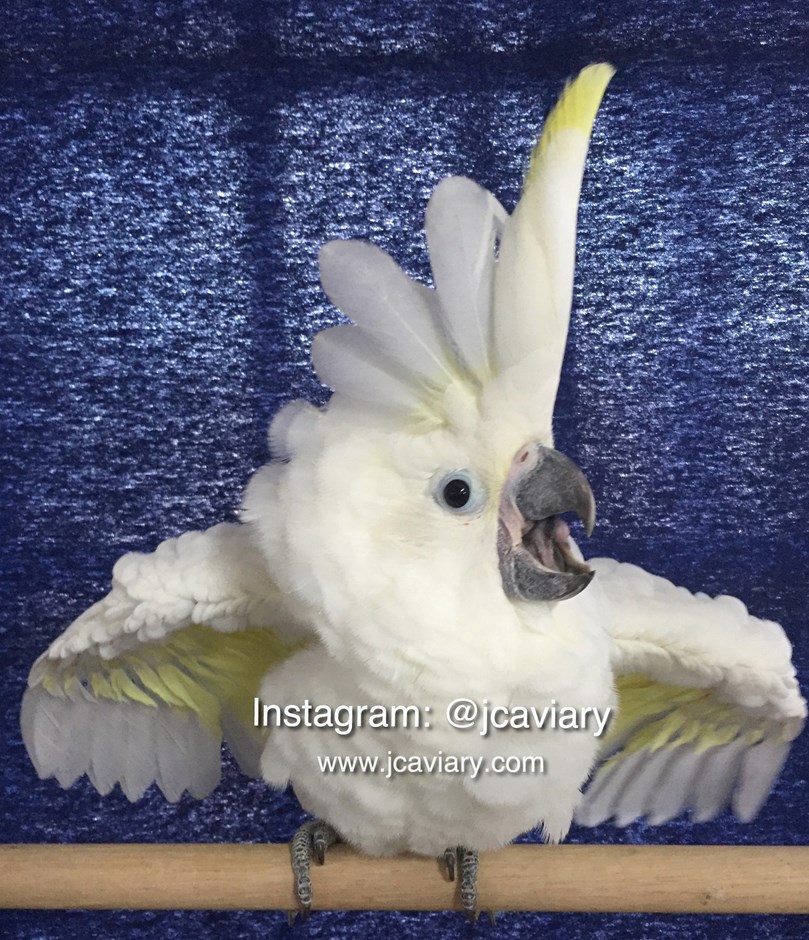

The nestling period is between 9 and 12 weeks, and the young fledglings remain with their parents for a number of months after fledging. Both parents incubate the eggs and raise the nestlings. Two to three eggs are laid and incubation lasts between 25–27 days. Like many other parrots it competes with others of its species and with other species for nesting sites. The nest is a bed of wood chips in a hollow in a tree. In southern Australia the breeding season is from August to January, whereas in northern Australia the season is from May to September. The sulphur-crested cockatoo is a seasonal breeder in Australia little is known about its breeding behaviour in New Guinea. These birds produce a very fine powder to waterproof themselves instead of oil as many other birds do.

They have been known to engage in geophagy, the process of eating clay to detoxify their food. These birds are very long-lived, and can live upwards of 70 years in captivity, although they only live to about 20–40 years in the wild. In captivity some will spontaneously dance to music with a variety of unique moves. The behavior spreads among the birds by imitation.
Triton cockatoo lifespan how to#
They have adapted very well to European settlement in Australia and live in many urban areas.īeing intelligent, in Sydney, Australia they have learned how to open garbage bins as a source of food. These birds are naturally curious, as well as very intelligent. Sulphur-crested cockatoos' distinctive raucous calls can be very loud, which is a result of an adaptation in order to travel through the forest environments in which they live, including tropical and subtropical rainforests. In captivity, the sulphur-crested cockatoo is easily confused with the smaller yellow-crested cockatoo or the blue-eyed cockatoo with a differently shaped crest and a darker blue eye-ring. However, corellas are smaller, lack the prominent yellow crest and have pale bills. It is similar in appearance to the three species of corellas found in Australia. fitzroyi but is smaller and has broader feathers in the crest, and C.
Triton cockatoo lifespan skin#
fitzroyi is similar to the nominate race but lacks the yellow on the ear tufts and has slightly blueish skin around the eye.

The differences between the subspecies are subtle. Males typically have almost black eyes, whereas the females have a more red or brown eye, but this requires optimum viewing conditions to be seen. The bill is black, the legs are grey, and the eye-ring is whitish. The plumage is overall white, while the underwing and -tail are tinged yellow. Sulphur-crested cockatoos are 44–55 cm (17.5–21.5 in) long, with the Australian subspecies larger than subspecies from New Guinea and nearby islands. Kai Islands and Ambon), but it is unclear if it has managed to become established there. This species has also been recorded as established in Hawaii and from various islands in Wallacea (e.g. In New Zealand, the introduced populations may number less than 1000. They have also been introduced to Palau and New Zealand. Outside Australia, they have been introduced to Singapore, where their numbers have been estimated to be between 5. Within Australia, sulphur-crested cockatoos of the nominate race have also been introduced to Perth, which is far outside the natural range. Northern Australia from West Australia to the Gulf of Carpentaria Restricted to the Aru Islands in the Maluku province of eastern Indonesia Except for highland areas, they occur throughout most of New Guinea and on nearby smaller islands such as Waigeo, Misool and Aru, and various islands in the Cenderawasih Bay and Milne Bay.įound in New Guinea and the surrounding islands They are numerous in suburban habitats in cities such as Adelaide, Melbourne, Canberra, Sydney and Brisbane. In Australia, sulphur-crested cockatoos can be found widely in the north and east, ranging from the Kimberley to as far south as Tasmania, but avoiding arid inland areas with few trees. A highly intelligent bird, they are well known in aviculture, although they can be demanding pets. They can be locally very numerous, leading to them sometimes being considered pests. The sulphur-crested cockatoo ( Cacatua galerita) is a relatively large white cockatoo found in wooded habitats in Australia, New Guinea, and some of the islands of Indonesia. Sulphur-crested cockatoo range (in red), introduced range (in violet)


 0 kommentar(er)
0 kommentar(er)
